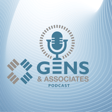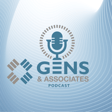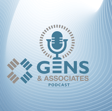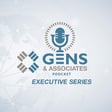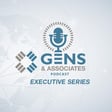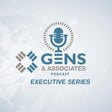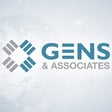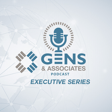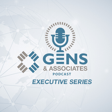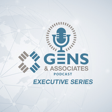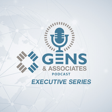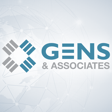Become a Creator today!Start creating today - Share your story with the world!
Start for free
00:00:00
00:00:01

Executive Series Episode #5 - Rajiv Rangan
Welcome to The Gens & Associates Podcast: Executive Series. This exciting series will feature Steve Gens, G&A Managing Partner, conversing with key senior executives that represent the software and services sectors. These informative one on one conversations will explore how they are guiding their organizations to effectively support key industry initiatives and technology advances.
In todays episode, host Steve Gens is joined by Rajiv Rangan (Co-Founder and Co-CEO of Freyr) to discuss the unique combination of regulatory services and software, advanced technology, as well as regulatory intelligence and how it benefits their costumers.
Transcript
Introduction and Welcome
00:00:00
Speaker
Welcome to the Gens & Associates regulatory executive podcast series. I'm your host, Steve Gens, managing partner of Gens & Associates. Today, I'm very excited to be speaking with Rajiv Rangan, co-founder and co-CEO of Freer Solutions.
Excitement for Freyr's Tech Advancements
00:00:17
Speaker
So I've been looking forward to this for quite some time, Rajeev. I know when I was on site in your Princeton office last month getting an update and on all the exciting things that are going on both on the services and software side. and especially I know one area will do a deep dive, um you know what you're doing on the advanced tech, it's it's very interesting, very practical too.
History and Evolution of Freyr Solutions
00:00:41
Speaker
But before we get started, could you give our listeners a brief history of rare solutions and maybe highlight some of the key services and software solutions? So again, welcome. Wonderful, ah Steve, thank you so much for um having me as a part of this podcast series, really, really excited.
00:01:01
Speaker
So let me start with a very brief introduction about myself. I primarily ah focus on ah business strategy, business growth, the branding, digital innovation at Freyr. I have about 25 years of experience out of which the past 15 years has been in various capacities in the life sciences regulatory value chain, both functional services and technology solutions business aspects.
00:01:26
Speaker
so To take you back in time, ah Steve, we formed Freyr about 13 years back. And as ah cliched or as classic of any startup story, ah we were a bunch of close friends. Some of us from the same college ah back in the mid-1990s, we came together and formed Freyr.
00:01:49
Speaker
And like any typical startup, this was in a basement, ah not in a garage. ah And the Starbucks in Princeton was our first office. So ah very humble beginnings, but extremely passionate when we started off and that passion and energy continues.
00:02:09
Speaker
till this date. So we started off, Steve, as primarily a technology solutions provider with some very modest beginnings to cover some white spaces in the regulatory value chain. um To be precise, it was the EVMPD solution and XeVMPD solution at that point where we thought there was a play. And there were a couple of ah big ticket industry acquisitions that had happened at that point. So we thought you know the timing was right for us to kind of venture out.
Global Expansion and Partnerships
00:02:40
Speaker
ah So though we start off as a global, um ah you know, like ah IDMP, XCVM PD solution organization, we rapidly evolved into a multifaceted regulatory services and solutions company. um So right from offering functional outsourcing services in the regulatory value chain, regulatory strategy,
00:03:05
Speaker
ah regulatory process consulting in country, regulatory affairs in several regions across the globe. And of course, regulatory digital software and RIM data services. um We evolved pretty rapidly into the whole host of regulatory services and tech solutions. And the reason we were able to do this was some very early breakthroughs that we got in with some large biopharma companies. And one thing led to another and we were supporting even during our early stages of an organization, about six of the top 20 biopharma companies in different regulatory functional areas. ah So as we were growing in the regulatory functional services area, we started establishing centers of excellence within each of the regulatory subdomain.
00:03:56
Speaker
ah For example, labeling is a center of excellence within Freyr. CMC is a center of excellence publishing and so on and so forth. So close to about 10 different centers of excellence.
00:04:08
Speaker
And each center of excellence had dedicated experts, ah process understanding, customer base, um rapid expansion, not just in our delivery hubs, but across countries. So we kind of grew razor focused on the regulatory value chain by deeply investing in individual centers of excellence within the regulatory ah subdomain.
00:04:32
Speaker
ah Another interesting thing happened around this time. ah While we had a few large pharma engagements, there were hundreds and probably thousands of ah inbound small to mid-size life sciences companies that started approaching Freyr.
00:04:51
Speaker
for supporting them in their regulatory needs. It could be you know a company in Korea wanting to enter the Eastern European market. It could be a company in Latin America wanting to establish a presence in Asia. So we started getting ah hundreds and hundreds of inquiries with many, many small and mid-sized companies.
00:05:09
Speaker
and And this helped us establish our global footprint. ah we We set up offices in different countries. We partnered with several consultants, and we hired employees in different regions. So we kind of fueled the in-country growth um at the back of many of our small and mid-sized customers. In addition to being a regulatory functional outsourcing partner, and all of this happened By taking a radically ah you know different approach to our branding and ah marketing early on in our company, we stayed away from conferences. As you're familiar with the industry, the you know the conferences are are a key part where
00:05:51
Speaker
ah vendors like us and sponsors collaborate. Nothing wrong with that. But we just thought, you know, we'll do something different. And we caught on very early on the social media digital marketing strategy. And that paid us significantly in the early early stages. And it still continues to ah you know ah fuel our growth in terms of thousands of inbound inquiries that we get in all our digital assets across the globe.
Freyr's Regulatory Services and Market Leadership
00:06:19
Speaker
So ah that kind of grew, and today as we stand in all humility, Steve, we are possibly the largest and only regulatory focused global organization that offers the entire stack of regulatory outsourcing services, that offers a regulatory digital tech platform, regulatory intelligence as a core,
00:06:46
Speaker
And last but not the least, global product custodianship, which includes market authorization holding LRs in you know hundreds of countries. So the entire ecosystem needed for the smallest of the small to the largest of the large life sciences companies ah to cater to their regulatory needs. Freyr is very well positioned. And not just for biopharma, but also for Medtech.
00:07:15
Speaker
as well as consumer products, Steve? Yes, a very impressive history, and it's only been 11 years. so um and And certainly from a a founder to founder, I think we talked about this when I was on site, kind of your basement story. you know Mine was the the spare room, and I had recalled that bulk spare room tycoon you know that was written by a brilliant entrepreneur in the Philadelphia area. you know It starts somewhere. and
00:07:47
Speaker
you know, having the right people, something that you're passionate about. And I always, you know, sometimes people say, well, what's your organization? And I think my organization as the life sciences community, you know, we're kind of here to serve. And maybe that's where we can start start out. um Because yeah, I agree, you guys are very unique as far as people talk about we have regulatory services, regulatory software.
00:08:14
Speaker
But having the strength and regulatory intelligence, really, that's the power of the triangle, right? And certainly our listeners really understand the complexity of Reg Intel with 150 or 80 markets, unique requirements. But I've always been amazed because there's only one other company that I've seen over the last 20 years. so They've long since been called ISI, where they started as regulatory services. They developed software to support the services. So you have that instantaneous daily feedback. And then all of a sudden, they took some of those products to market. And they were well behind in the ECTD. And just in a matter of a year and a half,
00:08:57
Speaker
they became the market leader. And I just think having that, that services connectivity, you know, with the software is a big strength. And again, you guys have the the reg and tell. So as you know, we've been tracking for air for the last four years, actually four to six years in our world class rim, you've always been strong in our innovation index, while the Everest group For those that are felt familiar with the Everest Group, ah they're much bigger than us and have a broader footprint, but they look deeply at services, you know, so regulatory and medical affairs services. And in 2024, they ranked fair as number one to a lot of really impressive competitors.
00:09:39
Speaker
So that's where my, and I think you already started alluding to this, what differentiates FRAIR from your competition? So again, ah the community we serve, they they see as innovators, and then the Everest you know Group, and for our listeners that don't know them, a very respected group has you ranked number one from regulatory and medical affairs services. So what differentiates FRAIR?
Unique Market Position and Integration of Intelligence
00:10:02
Speaker
So Steve, let me take that in three parts, one from an overall organization standpoint, and then maybe drill down a little bit on the services perspective, which is where Everest Group has ranked us as you know the topmost in the leader quadrant. And the third probably covered a bit on the digital tech ah in terms of how we stand out. So ah the first thing from an organization standpoint, like I just alluded to earlier,
00:10:32
Speaker
If you look at the four foundational pillars for any a regulatory ah function, right ah we have it all and we have not diluted our focus away from regulatory since inception.
00:10:49
Speaker
and we don't intend to. ah So in for the lack of any other word, just for some of the ah listeners who may not be familiar with Freya, ah we we are not a CRO. In the traditional sense, we are not a CRO. And that gives us a very unique ah competitive advantage. Because if you look at regulatory as the DNA, or regulatory as the as the focus point, and if you're looking at a player who can provide regulatory functional outsourcing at scale,
00:11:19
Speaker
who can provide in-country regulatory affairs services, who also has a technology for RIM, for submission management, for labeling, ah for regulatory intelligence, as well as a player where global regulatory intelligence is deeply embedded into the other three functions, which I just mentioned. that is There is nobody else out there. You do have ah some very strong companies in the regulatory intelligence space. You do have companies which are large service providers, large CROs, who also do regulatory functional outsourcing. And of course, you have some ah ah strong regulatory software and cloud companies.
00:12:03
Speaker
um offering different point solutions and end to end rim and so on and so forth. But but if if you if you if you kind of go foundational or if you zoom out 100,000 feet, is there one organization in the vendor landscape that is committed to regulatory and is doing all the four key elements with a deep intertwining of global regulatory intelligence in all the facets of the services or the technology and not seeing like regulatory intelligence as a separate ah entity or a separate service or a solution, we are possibly the only one. Now, this is the biggest differentiator. And this differentiator manifests itself in two different forms. Like I mentioned earlier, the smallest of the small companies growing, fast growing companies, startup biotechs,
00:12:53
Speaker
ah We act as practically their virtual regulatory department. We offer you know publishing experts, we provide regulatory strategy, the dossier strategy, ah all the way to you know cosmetic companies or medical device companies who want to get into a new market. ah We offer market intelligence and take them all the way to the filing and the post-approval and life cycle activities.
00:13:18
Speaker
um and and fast forward or switch gears to the large biopharma, as you know. um We are working with many of the large biopharma in multi-year, multifunctional, end-to-end regulatory outsourcing programs. right So that is fair. And because of this unique ecosystem, the synergies are very easy for us to um manifest between the groups. And because we built all these entities organically, ah to implement these synergies also become very, very easy. And the decisions are quicker, and implementations are very easy.
00:13:54
Speaker
ah For example, the GRI, the Global Regulatory Intelligence ah um as as a division, we instituted that as a division, not just offering it as a separate service and solution offering, but also very easily able to, um you know, interweave that into our services in the technology
Synergy of Services and Technology
00:14:13
Speaker
business. So that's at an organizational structural standpoint um that that gives us a unique ah ah differentiator. And last but not the least, the market authorization holding. I really want to call that out because ah We actually hold thousands of market authorizations on behalf of our customers in several countries. ah We are the local LRs. What that means is a significant on the ground intelligence about those markets, about those products, because our skin is in the game, and we have helped these companies establish and be ah be there a lot in the regional markets. So this ecosystem of in-country regulatory knowledge is priceless.
00:14:54
Speaker
And that again feeds into our global regulatory intelligence framework and platform and our services and our technology offerings. So that that is, I would say as an organizational standpoint, the the synergy between these four pillars. And from a services standpoint, I'll just probably ah quickly outline a couple of points.
00:15:15
Speaker
ah Since we are focused on regulatory, ah the brand of rare, not just from a customer standpoint, but also from an employee and attracting the best talent in the industry standpoint, ah we've been very fortunate.
00:15:32
Speaker
ah because of the Razor Focus brand that we have. ah So we've been able to attract the best talent ah wherever we established our presence, not just in the few hubs that we have, but also in many countries where we are able to actually attract some excellent talent. And um ah the other interesting differentiator we have from a services standpoint is the thousands and thousands of regulatory projects that we have done ah for many of the small and mid-sized customers. And we have closed about 1,600 plus customers across Medtech, Biopharma, and consumer. And ah ah these projects has, again, given us an enormous competitive advantage ah ah in terms of being able to deliver to the market at large. From a tech standpoint, from a digital tech standpoint, there are a few differentiators.
00:16:27
Speaker
ah One of the key differentiators which you already alluded to, Steve, is the aggregated industry knowledge ah that is coming in from these services engagements, that is coming in from thousands of complex real world projects ah through our centers of excellence, getting funneled into our digital platform. right ah That is something we, ah it's again, priceless.
00:16:52
Speaker
Our products and tech stack is not just built ah based on the vision of you know a couple of ah ah ah business analysts or a couple of people who have industry experience. But it is in addition to that, it is an accumulation and aggregation of almost a decade of um you know a services project experience that's funneling into product product requirements and automation requirements and AI requirements and so on and so forth. That's a huge, huge benefit what we are seeing and the other interesting thing as a market differentiator purely from a digital tech standpoint I would like to highlight is that about two and a half years back or close to about three years back we embarked on a complete ground up
00:17:40
Speaker
rewrite of our um regulatory cloud platform. We call it Freya Fusion. And it is it is completely built on AI first and automation first principles. It is built on ah composability principles, ah data composability, UX composability, application composability, and ah the entire um ah ah functional composability.
AI, Automation, and User Experience in Tech
00:18:06
Speaker
And truly,
00:18:08
Speaker
envisioning and desiring to offer a unified regulatory ecosystem, which is the the timeline here is very important from a market differentiator standpoint because we are doing it since the last two and half three years, we are able to infuse automation, we are able to infuse AI ground up and not just as an afterthought on a legacy code base. right ah and And because of the timing of our investments and timing of our rewriting of our digital stack over the last two and a half, three years, it also gives us a very unique possibility to implement conversational UI.
00:18:54
Speaker
um As we all know, ah RIM applications are extremely complex when it comes to the user interface, the screens are crowded. There's a lot of data points, ah product information, substance information, application information. ah There's so much of ah data points um that ah regulatory affairs or a regops person has to deal with on a day-to-day basis with the interface with any applications, including our own ah legacy applications that we had. But with the generative UI,
00:19:24
Speaker
ah We are able to give a conversational experience to ah ah the regulator ah regulatory affairs expert or regulatory operations expert. right and And this again is a huge differentiator, we believe, in terms of the user experience that we're able to offer with Freya Fusion. And like I mentioned earlier, augmented regulatory intelligence.
00:19:49
Speaker
regulatory intelligence is not ah just another module or another product in our solution offering. It is seamlessly available at the point of interaction. So for example, if you're working on a code core label and you're working on all the deviation um aspects of regional labels in, let's say, 30 markets, and you're using the labeling module, at the point of transactional interaction with the application,
00:20:18
Speaker
If there is a ah regional labeling guideline ah for a particular country that you're working on, the system will automatically push and prompt a pertinent relevant regulatory intelligence data point or what we call insight. It pushes you ah in in that instance so that you are getting real time curated regulatory intelligence embedded in different functional aspects of the product. Same thing I can give multiple examples, ah CMC change assessment and and an impact of a CMC change in multiple markets.
00:20:56
Speaker
right If you infuse regulatory intelligence right at that point, you're saving days and weeks and months of CMC impact assessment activity, which is traditionally done ah probably in a more linear and manual way. So like this, that's that's a very significant differentiator.
00:21:13
Speaker
And last but not the least, ah we are also relooking at content, ah ground up relook at content, which is all about documents and dossiers, and seamlessly including component-based authoring ah in our architecture. um Because unless you have that strong foundational data element, any generative AI or automation on top of it ah will not be successful. So these are, I would say, some of the differentiators from a technology standpoint. I just thought I'd cover that as well in terms of market differentiators.
00:21:50
Speaker
ah Yeah, a lot to digest, Rajiv. But let me comment on a, um you know, a few things that, you know, because it really, really has hit me, as far as some of the yeah the aspects about learning about an organization, you know, what they value, how they view it, like you said, you you took a different approach, you know, certainly having aggregated knowledge,
00:22:16
Speaker
you know from all the kind of the the services that you do um across you know hundreds of companies. you know Certainly, as opposed to brainstorming, hey, what are some of the digital opportunities, the use case, you get that feedback you know constantly. So there's also, with the hype of what's going on with some of the other technologies, there's also the very practical side of it. now And the practical side for me is you know people that you know do the work every day, they know where the automation or the application of AI um you know could be very successful versus it's just kind of an idea. So that's kind of built into it. And I think when you use the term, a lot of people ah talk about the regulatory platform or the RIM platform.
00:23:02
Speaker
But talking about it from a regulatory ecosystem, you know all the things you've been saying about the reg intelligence, the services, you know AI, and then you know the platform, the transactional systems, it's how they all work together. And you know the thing that struck me from this is you guys are in a position every day to have deep learning. So you have that aggregated knowledge over hundreds or thousands. And the only way I can compare it is in our early days of the benchmarking,
00:23:31
Speaker
where it might have been thirty to forty companies mainly top fifty maybe a handful of smaller organizations i would say we had an appreciation of what's going on but once we double that so say seventy eighty companies on this and got more diversity in the product portfolio started having some med tech you know a few diagnostic companies, generics, when you have that and with our benchmarks, you know especially with the small pulse surveys, so we have two or three different a year, that's where we find the deep learning at. you
Deep Learning and Regulatory Ecosystem Approach
00:24:05
Speaker
know So it's like, yeah, we can get a perspective of a smaller survey sample, but once we get the much larger, it becomes very clear. And then the differences, like you said, with the the very small companies,
00:24:16
Speaker
where it's all about scale, right? And when do we implement certain things based on time versus the larger organizations? You know, they're just dealing with a lot of complexity because of their size. Now, my next question,
00:24:30
Speaker
um And you've already answered most of it, because we've been impressed with, you know, how you think and experiment with some advanced technology. So maybe very briefly, could you just highlight, um you know, maybe a few in the short and longer term, you already mentioned the CMC, and I know you guys are working on the health authority correspondence, but maybe very, very quickly highlight some of the current advanced technology initiatives that are adding value to your customers.
00:25:00
Speaker
Sure, Steve. um So probably I'll take that in two two buckets, right? um One, um ah like a DNA of innovation since inception, like I mentioned earlier, we start off as a tech innovation company. So though we grew exponentially on the services side, there was always a streak of innovation um in parallel that was going on.
00:25:27
Speaker
So even before the onset of JNAI becoming a household name ah since last year, so we actually had some method to the madness in terms of um innovation, right? So ah we called it incremental innovation.
00:25:46
Speaker
So we looked at process steps which are very granular, ah which are repetitive, which um you know which have a problem probably a huge cost implication to those steps. And we built a model called AX model, which is more like an internal model, and ah started scoring many of these regulatory process steps in terms of operational index or technology index and business index.
00:26:13
Speaker
And what this helped us do was that ah even like four or five years back when we were ah supporting customers and trying to win business on the regulatory functional services, we always brought in an element of a common sense based automation approach. For example,
00:26:32
Speaker
If you look at, the ah you know, m&a scenarios. Right. And as we all know pharma is is this is always m&a that's happening so downstream of any m&a in big pharma you have a lot of labeling changes you have a lot of artwork changes, and the way these services were typically done.
00:26:50
Speaker
took about three to five years for any vendor to to implement these changes. ah So we kind of looked at it a little differently and we said, the you know, ah can we do something differently, right? For one of the large pharma M&A that was happening, ah we had to change about, I believe like 20,000 labels and to sorry, 20,000 artworks.
00:27:11
Speaker
and different labels ah to harmonize the new entity's name and logo and stuff like that. And of course, have to QC that from a regulatory standpoint. So we we took an automation approach. So a very simple approach. And what that helped the sponsor company was to reduce the timeline from a three and a half, four year implementation to just about a year.
00:27:35
Speaker
ah so We had a hybrid approach where we had teams that were QC-ing these labels and artwork rather than designing them from scratch. ah We flipped it with automation and made them QC so that we didn't need as many people and as much time to redo the artwork from scratch. so Like this, there were several examples in medical literature search in in CMC function, which I alluded to, where there has always been a streak of incremental innovation.
00:28:05
Speaker
And the tool or the technology is incidental. So these innovations, we did it sometimes with an Excel macro. We did it with the PDF plugin. We did it with the um you know RPA and of course, generative AI as well. So that has been our um history with automation and innovation in terms of infusing technology. And we kind of fondly call it regulatory process digital outsourcing.
Innovation in Regulatory Processes
00:28:33
Speaker
So instead of just regulatory process outsourcing, we we started calling it as RPDO, regulatory process digital outsourcing. Now fast forward, and if you look at the last two to three years, there is another streak of ground up innovation ah that's happening as a part of our Freya Fusion platform, where we are looking at ah automation, ah not necessarily AI, but automation
00:29:00
Speaker
ah which may include AI or which may not, but the point is this aggregated knowledge of different companies doing different process steps, right? We are actually able to identify the least common denominator or the best possible road to do something without having any compliance impact and so on and so forth. And we are able to bring that into the automation first principle in the Freya Fusion platform. um And when you bolt on component authoring when you bolt on generative UI um and when you bolt on a unified data model, ah it it just fundamentally transforms the possibility of what you could do with an AI first unified rim.
00:29:48
Speaker
from any which way you look at it, transactional perspective or a decision-making perspective or a regulatory strategy or a regulatory intelligence perspective, whichever way you want to slice and dice, including submission and publishing, where we have done a lot of automation in terms of hyperlinking QC automation um and and you know many granular automation steps within the publishing and submissions world. So right from the operations aspect to the regulatory strategy aspect,
00:30:17
Speaker
ah There are many, many areas where our technology, um both incremental innovation as well as disruptive innovation as a part of Freya fusion, ah we are able to bring to the table.
00:30:31
Speaker
Yeah, thanks for that. And I'm certainly a ah big fan of incremental innovation, because it's it's all about continuous improvement. The disruptions you know come now and then, maybe every five, 10 years, even though that's getting shorter. But some companies lose sight. And actually, our top performers in our study, 100%, all of them, have a data-driven continuous improvement program. So they're always looking for,
00:30:58
Speaker
you know those successes. um And so I really like the the story of the incremental innovation because a lot of times companies that are looking for what I would call the silver bullet, those big ones. And it's just, hey, a series of small wins equals a big win. So finally, as a co-founder, what would be the one thing that excites you most about where Frere's going in the coming years?
Future of Integrated Solutions and Closing Remarks
00:31:24
Speaker
So Steve, if I were to pin one aspect of where Freire is going and where ah we can we can genuinely transform the industry is um where we think the fusion of services and technology and that's one of the reasons we are calling it Freya fusion because from a commercial standpoint there is a true possibility of having regulatory functional services and regulatory technology in a box.
00:31:56
Speaker
ah So if you're a large pharma, today you're you're having ah different technology vendors within the regulatory ecosystem. You have different regulatory services vendors in the regulatory ecosystem. But truly simplifying this model of using the technology and the functional services and bolting on in-country regulatory intelligence ah is is something that We think ah we are very excited with the scale and depth of how we can solve this problem for some of the large biopharma companies, med tech companies and consumer healthcare companies. So we're very excited and this is also a nice amalgamation of ah the four core pillars ah that Freire was founded on, the core principles and the growth vision for Freire. It kind of amalgamates into this vision for the industry.
00:32:52
Speaker
So very impressive and going back that it just started with some close friends in the basement um yeah back 13 years ago in 2011. And as so you know kind of founder to founder, I look back and kind of what begins an associates benchmark means to industry and could I even vision that back in 2005 where it was just a laptop a cell phone a pen and a pad and getting my first you know kind of customer so congratulations a very very impressive track record and we're expecting
00:33:26
Speaker
you know, great things to continue from Freire, maybe, um you know, have you back in next year or so. You can give us an update. So I'm sure some of our listeners want to get a hold of you or Freire. I mean, should they go to your website on LinkedIn? What would you suggest? Sure. So, you know, you could go to our website FreireSolutions.com.
00:33:48
Speaker
um F-R-E-Y-R solutions dot.com. We recently actually read our website after a few years. There is a get in touch option where you could you know put out your inquiry or if you want to speak to someone, could you could use the get in touch a button that's available in our website on the top. If you would like to reach out to me, my email ID is rajeev.rangan at rare solutions.com.
00:34:18
Speaker
r-a-j-i-v dot r-a-n-g-a-n at fairsolutions.com. ah Really would be happy to connect with anyone that's ah ah looking to hear from us and happy to support in whatever way we can.
00:34:35
Speaker
All right, excellent. And, um you know, on this end, with our listeners, any questions for the Gens and Associates team, you know, just to go to our contact page on the website, or I'm on LinkedIn, you know, talking about, you know, kind of the ah different way, you know, I'm the big user of LinkedIn, just reach out. And thank you again. This has been a really rich conversation. Congratulations again.
00:34:59
Speaker
you know with you and and you know the the team of your Cliff's friends that i started out in the basement. And it's very, very impressive where you're at. And I know a lot a lot of clients rely on core services you know to get through their daily activities and the strategic activities every day. So congratulations again. And um let's get back together on a follow-up podcast maybe at some point next year, Rajiv. So thanks again.
00:35:26
Speaker
Absolutely, Steve. Thank you so much. It's all very humbling and does feel like a dream. ah But very, very happy to be part of your podcast series. We always enjoy our interactions. ah We learn a lot from from interacting with you and the team. So really looking forward to many more. Thanks for having me.
